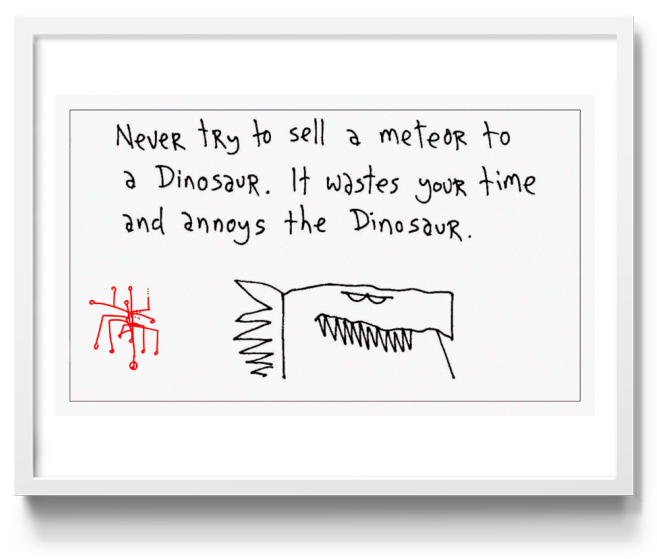Let me start with a brief digression, before circling back to the actual point of this post …
Winning startups are built from a combination of exceptional people, breakthrough technologies and/or disruptive business processes (preferably all three). However, there is also an element of being in the right place at the right time.
Every once in a while, a blend of forces comes together to create a unique set of conditions that enable the formation of exceptional startups … the sorts of startups that rise from the lab to global domination in less than a decade … you know the ones I mean … the Microsofts, the Googles and the Facebooks of the world. These are the truly magical moments in the history of startups.
I believe we are right in the middle of one such moment.
There are three interesting trends (among others) that have come together to create powerful building blocks for innovation:
- Fundamental changes in the economics of building a high technology based business (cloud computing, open source, a rich ecosystem of reusable components and services, etc.)
- The rise of the real-time web, social networks and massively concurrent global conversations.
- The unbelievable expansion of devices at the edge of the network (replete with new features and capabilities such as LBS). By the way, I am not only referring here to the explosion of smartphones & tablets, but also to the pending ramp of a myriad of other devices (what some people call the Internet of Things).
Information (or data in its raw form) is being generated, shared and exploited like never before in human history. It’s the “never before in human history” bit that is an important catalyst for the creation of entirely new business opportunities. It is an also an important catalyst for generating hugely disruptive threats and/or pressures to existing businesses.
It’s a volatile and powerful combination. Call it a primordial soup of innovation if you like.
We’ve already seen the first wave of “consumer” focused companies rise from this era, and we will no doubt see many more. What we have yet to see, I believe, is the commensurate rise of the next generation of “enterprise” focused companies. It is clear to me that enterprises are on the verge of aggressively exploiting (both opportunistically and out of necessity) this new wave of ideas/innovation.
I actually grew up in the Enterprise Software space … in what you might call its “golden age”.
INEA (my first startup) focused on helping financial institutions measure and manage the present (profitability by customer, product, line of business, etc.), while laying the foundation for the future (planning and forecasting). Doesn’t sound that sexy right? Well think about this … a wise banker once told me that “running a bank was like driving a supertanker … blindfolded”. Scary huh? Well, INEA was in the business of helping financial institutions deal with that big hairy problem.
By the time INEA was acquired by Cartesis in 2005 (which was subsequently acquired by Business Objects and SAP), our software was powering some of the worlds largest and most complex financial institutions, and had been deployed in over 40 countries.
As a small company, we kicked ass. We were the David to the Goliaths of the ERP world, and we won because we leveraged our most precious resources: our unique knowledge, a fanatically loyal customer base, our amazing team and an incredible ability to innovate quickly.
Following the sale, and after a fascinating stint as an EIR at Ventures West (one of INEA’s investors), I had the opportunity to become part of a very different type of business. In fact, one about as far away from enterprise applications as I thought I could get :-)
Viigo, which grew to be one of the most highly downloaded BlackBerry apps of all time, was a nimble, fast growing, mobile software company, powered, again, by an exceptional group of people. Unlike the 6 to 7 figure deals that were common at INEA, we gave Viigo away for free, leveraging a “late monetization” strategy to generate revenue. While the millions of downloads were our initial measure of success, by the time of the acquisition, we were starting to generate significant revenue.
What was interesting about this revenue was that it was becoming heavily dominated by enterprise purchases. It was clear that that enterprises were starting to wake up to the power of real-time information in the hands of front line workers. But it was only a start, and I sense that there is much more to come.
So, to the point of this whole meandering conversation …
When we closed the Viigo transaction in March of this year, as I had done with INEA in 2005, I agreed to remain with the buyer for 6 months in order to help ensure the rapid and successful integration of the company.
The integration with RIM worked well. Thanks to the experience of both teams and the hard work of both sides, we had integrated and/or cut over all core business processes within 90 days, and the Viigo teams were docked safely into their new homes. Note: the really exciting stuff, the result of the technical phase of the integration, will be evident shortly :-)
At RIM I had a chance to work with one of the most interesting and stimulating groups in the organization. The Strategic Alliances team, which is responsible for M&A and strategic business development, is filled with bright, dedicated and passionate people, and it was a pleasure to work with them on some fascinating projects, not to mention being able to witness the acquisition process from the other side.
So, why would one want to leave all this after 6 months?
It isn’t that I don’t believe in the future prospects of RIM, or that it wouldn’t be a fun place to work, it is just that the lure of startups is too strong. Nothing can compare to the thrill of building a startup, and/or working closely with a startup community.
Most importantly, nothing can compare to the opportunities that I believe are present for startups at this current point in time.
Just looking at Toronto and Montreal, and the wave of innovation that is happening in these cities alone, and I can’t help but feel that it is the most exciting we have seen in many generations.
And what better way to begin the next phase of my journey than by participating in the first StartupWeekend ever in Toronto. I’m looking forward to hanging out with the teams, this weekend, as they work hard to build real products within 54 hours. I’ll be speaking on Saturday evening about one critical element in the lifecycle of a startup ... namely pitching your first VC. Hope to see you there.
To the Viigo Team, it was a wonderful experience working with all of you ... you are what made the whole Viigo success possible ... I look forward to keeping in close touch ... and perhaps even working together again one day. (caveat caveat: subject to non-solicit, non-hire, no talky-talky clauses, etc.)
Mark





